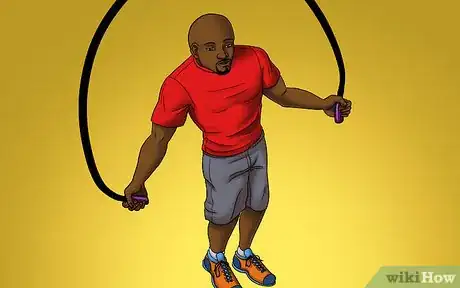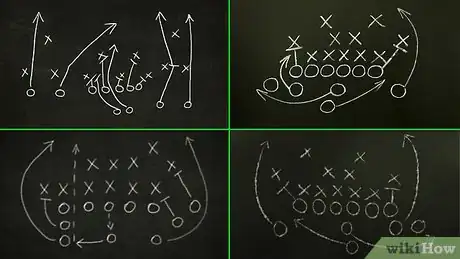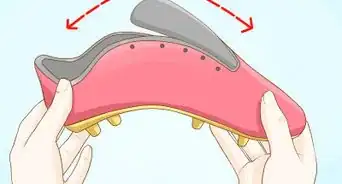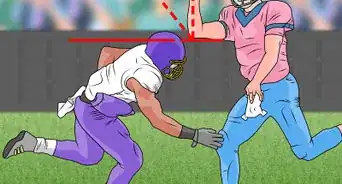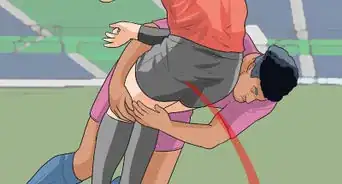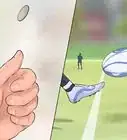wikiHow is a “wiki,” similar to Wikipedia, which means that many of our articles are co-written by multiple authors. To create this article, 56 people, some anonymous, worked to edit and improve it over time.
This article has been viewed 204,246 times.
Learn more...
To be the best wide receiver on your (American) football team, you have to be fast and be able to catch well. Receiver is what they call a "skill position," and there's some glory that comes with it, but you have to be pretty tough to withstand the physical abuse that accompanies the position, too. That means you really have to want to play wide receiver. It's a tough job -- even a little dangerous! -- and it requires a lot of work. Here are some suggestions for improving your chances of success.
Steps
Learning About the Position
-
1Learn about the different wide-receiver positions.[1]
- Split end. A receiver on the line of scrimmage split one or more steps outside the tackle. The receiver has to be fast and strong enough to break through a jamming opponent at the line and quickly get open for a pass.
- Flanker. A receiver behind the line of scrimmage split one or more steps outside the tackle. He has to break through and past opponents at the line The flanker is on the same side as the tight end, lined up just like a split end but a step or two behind the line.
- Slot back. He lines up in the backfield between the split end and the tackle.
-
2Watch professional wide receivers. Learn from the pros. Watch how they move and interact with the ball so you can emulate what works for them.
Perfecting Your Skills
-
1Create a workout routine. To be a wide receiver you must be fast and agile. Strength is not usually as important but comes in handy when an opponent tries to tackle you.
-
2Work on speed and agility.[2] For example, do several 20-yard dashes in succession. Increase your distance to 25 or 30 yards (22.9 or 27.4 m) for several repetitions. You need to be able to run hard many times with only short breaks in between. The faster you move, the more likely it is you'll be able to evade the defense.
-
3Work on stamina. Take jogs and maintain a breathing pattern to prevent cramps.
-
4Run routes: the slant, hitch, curl, hook, and post.[3] Your coach or a teammate can demonstrate each to you.
-
5Practice catching on the routes. As a receiver you'll be catching the ball a lot, so practice catching as much as you can. A simple game of catch is good, but try to hook up with a good passer who can help you run routes and take good passes.[4] A good passer will lead you with the ball (that is, he'll throw to where you will be, not to where you are.)
- Develop "soft" hands. In other words, provide a "cushion" for the ball as it arrives. You don't want the ball to bounce off your hands.
- Look at the ball until it's safely in your hands. Looking for an opponent before you have full possession of the ball often results in an incomplete pass.
-
6Keep at it. Practice every day. If you slack off, it's easy to lose your competitive edge.
-
7Learn trick plays. Also known as "fakes," these are designed to fool the opponent. Wide receivers are sometimes called on to appear to run a particular play but then suddenly run something else.[5] In other words, you're called upon to be a good "actor."
Community Q&A
-
QuestionHow do I get my wide receiver coach to notice me?
 Community AnswerYou have to make plays. Every time the ball is thrown to you, catch it. If it's a bad throw, dive for it. Use stick moves with your routes to create separation.
Community AnswerYou have to make plays. Every time the ball is thrown to you, catch it. If it's a bad throw, dive for it. Use stick moves with your routes to create separation. -
QuestionHow can I improve my route running?
 Community AnswerYou're going to have to listen to the plays your coach calls and study your playbook to know your routes. After that, just practice plays over and over again with your QB to make sure the play you're running is perfect.
Community AnswerYou're going to have to listen to the plays your coach calls and study your playbook to know your routes. After that, just practice plays over and over again with your QB to make sure the play you're running is perfect. -
QuestionWhat football position should I be if I'm small?
 Community AnswerWide receivers, and also small people tend to have more speed which you can burn the cornerbacks and safetys.
Community AnswerWide receivers, and also small people tend to have more speed which you can burn the cornerbacks and safetys.
Warnings
- Don't try to show off or make flashy catches. You could tear an ACL or break a bone.⧼thumbs_response⧽
- Wide receivers get tackled a lot. You have to be able to take a hit, sometimes when you're off-balance and vulnerable. Football is a rough sport, and wide receiver can be a rough position.⧼thumbs_response⧽
- Always stretch before playing to prevent pulling or even tearing a muscle.⧼thumbs_response⧽
References
- ↑ https://football.calsci.com/Positions6.html
- ↑ https://www.youtube.com/watch?v=WaXn_Oncc6U
- ↑ https://www.youtube.com/watch?v=j0gxiYU4jLg
- ↑ https://football.calsci.com/Positions6.html
- ↑ https://football.calsci.com/Positions6.html
- https://www.youtube.com/watch?v=L-_JRyoAfCw
- http://en.wikipedia.org/wiki/Wide_receiver
About This Article
Before you can become a good wide receiver, you'll need to research and understand the different wide receiver positions, like split end, flanker, and slot back. Once you have learned about these, develop a workout routine that improves your speed and agility. Doing several 20 to 30 yard dashes in a row will improve your ability to catch passes. Also practice running routes, like the slant, hitch, and curl, under your coach's guidance. For advice about catching the ball with "soft hands," keep reading!
